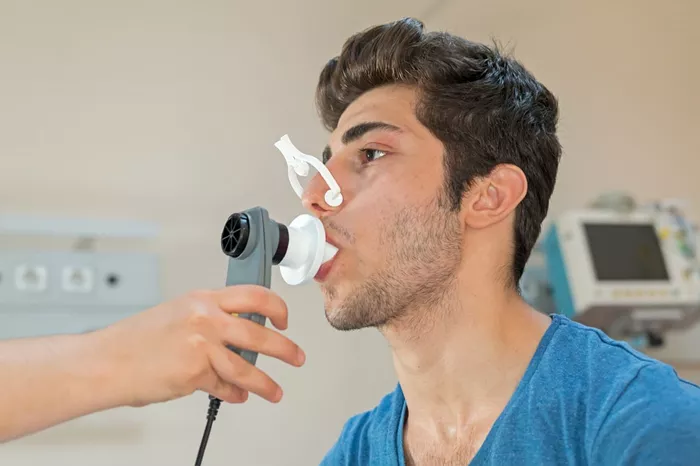Asthma, a chronic respiratory condition affecting over 4.6 million children in the U.S., has long posed challenges in diagnosis and treatment. Traditionally, asthma is categorized into two primary types: “T2-high” and “T2-low.” However, distinguishing between these subtypes and matching children with the appropriate treatment has been difficult, primarily due to limitations in existing testing methods. A novel nasal swab test developed by researchers at the University of Pittsburgh could soon change that, offering a more accurate and personalized approach to asthma diagnosis and treatment.
For years, diagnosing asthma subtypes in children has been imprecise. While the most common form, “T2-high” asthma, involves inflammation triggered by T helper 2 cells, another form, “T2-low” asthma, represents a diverse group of asthma variants that don’t respond to the same treatments. Diagnosing these subtypes usually requires invasive and sometimes inaccurate tests, such as blood draws to measure immune cells or a breath test to measure nitric oxide levels.
But now, the research team at the University of Pittsburgh has introduced an innovative alternative: using nasal swabs to collect genetic material, which is then sequenced to detect specific inflammation markers linked to various asthma subtypes. This method allows doctors to more accurately diagnose and treat asthma based on the underlying genetic causes of the disease, rather than relying on generalized approaches.
In a study published in JAMA, researchers tested the nasal swab on over 450 children and teenagers from three different locations—Puerto Rico, Pittsburgh, and a combined study in both regions. The results were promising, showing that the nasal swab test could effectively identify the different subtypes of asthma, including the elusive “T2-low” form, which has been linked to environmental factors such as air pollution.
“T2-low” asthma is more common in areas with high levels of pollution, and the study revealed that children from Puerto Rican and Black communities—who are disproportionately affected by environmental factors like pollution, dust, and mold—were more likely to have this form of asthma. These groups also experience higher rates of asthma-related complications and deaths compared to other children in the U.S.
The ability to diagnose this subtype more accurately is crucial, as it could lead to better-targeted treatments. Dr. Juan Celedón, one of the paper’s authors and chief of pulmonary medicine at UPMC Children’s Hospital of Pittsburgh, emphasized that this breakthrough could mark a significant step toward personalized asthma care. “This is a necessary first step for better personalized medicine,” Dr. Celedón said.
The standard treatment for asthma, particularly the more common T2-high variety, involves the use of inhaled steroids. However, for children with moderate to severe asthma, steroids alone may not suffice. Over the last decade, injectable and intravenous treatments have been approved for these patients, targeting the molecules responsible for inflammation. These treatments, however, are primarily effective for T2-high asthma.
The nasal swab test could play a critical role in identifying children with “T2-low” asthma, paving the way for future studies and treatments specifically designed for this less understood form. According to Dr. Celedón, the test could eventually help match patients with more effective treatments, reducing reliance on a one-size-fits-all approach. “Instead of treating most people the same, in a few years, we can treat you better according to the type of asthma you have,” he said.
The study’s focus on children from Puerto Rican and Black communities is significant, as these populations have historically been underrepresented in asthma research. Dr. Gurjit Hershey, director of the asthma research division at Cincinnati Children’s Hospital, praised the study’s inclusivity, noting that previous asthma studies have predominantly involved white European populations. “To have a study that really focuses on Puerto Rican and Black children is important,” she said, underscoring the need for diverse research to address the unique challenges faced by these communities.
Despite the promising results, experts caution that more research is needed before this nasal swab test can be widely implemented. Dr. Jessica Hui, a pediatric allergist at National Jewish Health, pointed out that while the test holds great potential, genetic sequencing is a specialized and costly process that requires expertise. “It’s a very specialized type of analysis,” she said. “It’s not like this is something we can implement immediately, but for sure it’s an exciting direction.”
Additionally, Dr. Hershey raised concerns about whether a child’s asthma type could change over time, particularly in response to environmental factors like pollution or allergens. “The place to be cautious is, does it make sense to treat based on this?” she noted, emphasizing the need for further studies to explore how asthma types may evolve over a child’s life.
While this new nasal swab test is not yet ready for widespread use, it represents a major step forward in asthma research. If FDA approval is granted and further research confirms its effectiveness, the test could revolutionize how asthma is diagnosed and treated, especially for children in high-risk communities. As researchers continue to explore the potential of personalized treatments, the hope is that in the near future, asthma care will become more tailored and effective, offering relief to millions of children struggling with the disease.
Read more:
- Arctic Freeze Hits The UK: Snow, Ice, And Health Warnings Take Over
- Drinking Water And Health: Does Extra Hydration Offer Significant Benefits?
- Alcohol And Health: The Controversy Behind U.S. Dietary Guidelines And Public Health


